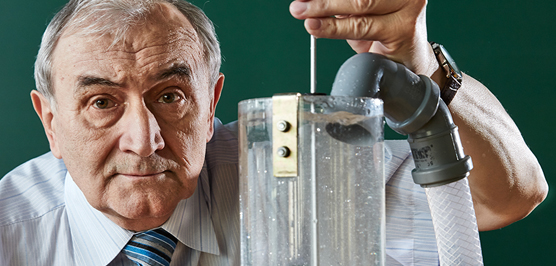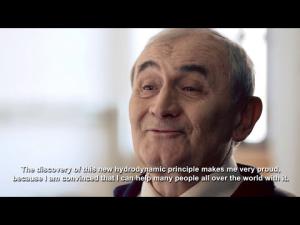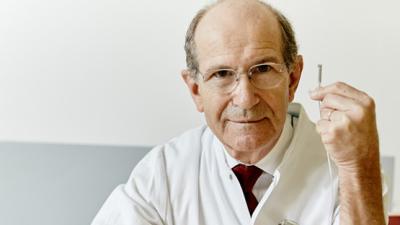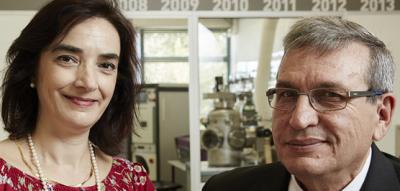Miroslav Sedláček
Rolling fluid turbine
Finalist for the European Inventor Award 2016
by Miroslav Sedláček and marketed since 2015, promises to change how water current is transformed into electrical power, expanding application of hydropower technology to a myriad of previously untapped sources, including ocean tides and small brooks. Sedláček's "rolling fluid turbine" is a viable alternative to conventional hydropower dynamos, which have been generating power from water since they were first developed in the 1880s. Whereas traditional dynamos rely on blades submerged in high-velocity water streams, the rolling fluid turbine relies on physics to convert water's natural flow into upward pressure to generate electricity.
Sedláček achieved his breakthrough by exploiting a curious hydrodynamic principle: the rolling fluid principle - a vortex dynamic which creates tremendous amounts of energy. By leveraging the naturally occurring suction of water and pumping it through a specially shaped turbine casing, Sedláček has been able to generate power with an output of up to 10 kilowatt hours (kWh) per day at efficiencies of 50-60% - enough power from a small turbine to meet the electricity demand of five European families or an entire African village.
Societal benefit
Energy generation from fossil fuels remains a major burden on the environment, accounting for an estimated 10 billion tonnes of CO2 emissions per year (ScienceDaily). Although the European Union aims to cover 20% of its energy demand from sustainable resources by 2020, about 25% of the electricity currently used is produced from coal. In Germany, the EU's largest producer of wind and solar energy, the share of coal in energy production is as high as 45% (Bloomberg).
Hydropower generation could become more relevant for the energy mix now that Sedláček's invention makes it possible to tap a significantly wider range of water resources. According to the European Ocean Energy Association, wave and tidal energy generation in Europe will reach 188 gigawatts by 2050, enough to meet 15% of Europe's electricity demand and up to 20% of national demand in some countries.
Economic benefit
Marketed by start-up company Vortex Hydrokinetics LLC under the brand name SETUR Bladeless Turbine in 16 countries since June 2015, Sedláček's invention is currently being tested by German‑based utility company E.On Group, among others, for municipal power generation. Based in Palm Beach, Florida, with seven employees working on hydropower projects, Vortex Hydrokinetics LLC is a subsidiary of Ocean Energy Industries. Its WaveSurfer technology already generates more than 32 megawatts per facility, e.g. at installations in Avacha, Ukraine.
The invention has also been marketed by Prague-based company P.F-Economy Consulting Ltd. under the brand name Bladeless Rolling Turbine (BRT) since October 2015. BRT is intended for small-scale applications in streams and brooks.
In the European Union, one million people currently work in the renewable energy sector, a market worth over EUR 130 billion a year and annually exporting EUR 35 billion worth of renewables. Sustainable energy (solar, wind, water) currently accounts for 15.3% of gross final energy production in the EU. In North America, total revenues from hydrokinetic power generation are expected to reach EUR 148.7 million (USD 163.27 million) in 2017, according to Pike Research.
How it works
The invention is a tubular canister - approximately the size of a microwave oven - that floats like a buoy on the surface of, for instance, a brook or small stream. Beneath the surface, the turbine directs the natural flow of water through a round shaft, driving the water pressure upwards with increased suction as a result of the vortex principle. Inside the turbine shaft, the powerful vortex energy rotates a cup fixed to a generator shaft that converts the rotation into electrical energy.
Even when installed in a small water stream, the turbine has been proven to generate sufficient energy for a small house at levels of 100 to 400 watts nominal performance. Ideally, the bladeless turbine operates at water flow levels of 22 to 250 litres per second, but it will already yield results at levels as low as two litres per second.
The inventor
Having obtained his engineering degree at the University of Economics, Prague, Czech Republic, in 1976, Miroslav Sedláček pursued research into energy generation based on hydrodynamic principles, which led to his continued focus on the "vortex" principle.
Sedláček and his team of inventors at the Czech Technical University in Prague spent 12 years developing the vortex principle technology, filing five key patents in the process. He is currently an associate professor at the Department of Economics and Management in Civil Engineering of the Czech Technical University in Prague.
The turbine design has won several international awards, including the E.On Energy Globe Award, Czech Republic, in the Idea category (2014), the WIPO Inventor Award (2013) and the Copper Award at the 6th International Exhibition of Inventions in Suzhou, China (2008).
Did you know?
The vortex-inspired turbine is part of a trending segment of high-tech inventions emulating phenomena found in the natural world. These "biomimetic" inventions - from the Greek "bios" (life) and "mimesis" (imitation) - are driving a booming market: By 2025, biomimicry could account for EUR 272.2 billion (USD 300 billion) of the United States' annual GDP and provide 1.6 million jobs in a global market worth as much as EUR 900.7 million (USD 1 trillion) (PointLoma).
Prominent examples of biomimetic inventions include Velcro fasteners originally mimicking sticky burrs and even past European Inventor Award winners such as the "Pyrosequencing" method for DNA analysis, modelled on the luminescence of fireflies at night, or the "Aquaporin" water purification membranes based on naturally occurring proteins. Past EIA finalists drawing on the power of natural phenomena include fractal-based antennas and the "Fastskin" swimsuit inspired by shark skin.
Media gallery
Patent numbers:
Contact
European Inventor Award and Young Inventors Prize queries:
european-inventor@epo.org Subscribe to the European Inventor Award newsletterMedia-related queries:
Contact our Press team#InventorAward #YoungInventors









